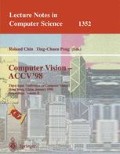Abstract
In this paper we propose a new method for the estimation of rigid motion from two monocular images when less than eight point correspondences are available. The motion parameters are found using the essential matrix. By employing previously unused constraints on essential matrix, we show that it can be estimated through the minimisation of a two-dimensional cost function defined over the space of all possible directions of translation. The new formulation is easier to understand and implement than previously proposed approaches, and has a low computational cost. The algorithm has been evaluated on synthetic data. Our experiments show that that the new method is capable of finding all solutions and that choice of initial state is not critical.
Preview
Unable to display preview. Download preview PDF.
References
Aggarwal J.K. and Nandhakumar N., “On the computation of Motion from Sequences of Images — A review”, Proceedings of the IEEE, vol. 76, pp. 917–935, 1988.
Faugeras O. and Maybank S., “Motion from Point Matches: Multiplicity of Solutions”, Intl. Journal Computer Vision, vol. 4, pp. 225–246, 1990.
Heeger D. and Jepson A., “Subspace Methods for Recovering Rigid Motion I: Algorithm and Implementation”, Intl. Journal Computer Vision, vol. 7, pp. 95–117, 1992.
Huang T. and Faugeras O., “Some Properties of the E Matrix in Two-View Motion Estimation”, IEEE PAMI, vol. 11, 1310–1312, December 1989.
Longuet-Higgins, H.C., “A computer algorithm for reconstructing a scene from two projections”, Nature 293, pp. 133–135, 1981.
Longuet-Higgins, H.C., The reconstruction of a scene from two projections-configurations that defeat the 8-point algorithm”,Proc. IEEE 1 st Conf. On Artif Intell. Applications, pp. 395–397, 1984.
Luong Q.T. et al, “On determining the fundamental matrix: analysis of different methods and experimental results”, INRIA TR-1894, INRIA-Sophia Antipolos.
McReynolds D. and Lowe D., “Rigidity Checking of 3D Point Correspondences Under Perspective Projection”, IEEE Trans. PAMI, vol. 18, pp. 1174–1185, 1996.
Netravali A. et. al. “Algebraic Methods in 3-D Motion estimation from TwoView Point Correspondences”, Intl. Journal of Imaging Systems and Technology, vol. 1., pp. 78–99, 1989.
Trajković M. and Hedley M. “The eigenspace method for motion recovery from less than eight point correspondences”, (manuscript in preparation).
Weng J., Huang. T and Abuja N., “Motion and Structure from Image Sequences”, Springer-Verlag, 1993.
Author information
Authors and Affiliations
Editor information
Rights and permissions
Copyright information
© 1997 Springer-Verlag Berlin Heidelberg
About this paper
Cite this paper
Trajković, M., Hedley, M. (1997). The eigenspace method for rigid motion recovery from less than eight point correspondences. In: Chin, R., Pong, TC. (eds) Computer Vision — ACCV'98. ACCV 1998. Lecture Notes in Computer Science, vol 1352. Springer, Berlin, Heidelberg. https://doi.org/10.1007/3-540-63931-4_241
Download citation
DOI: https://doi.org/10.1007/3-540-63931-4_241
Published:
Publisher Name: Springer, Berlin, Heidelberg
Print ISBN: 978-3-540-63931-2
Online ISBN: 978-3-540-69670-4
eBook Packages: Springer Book Archive

